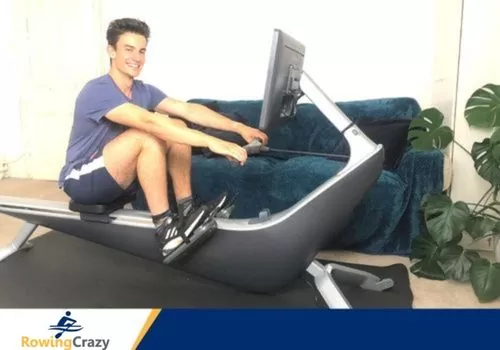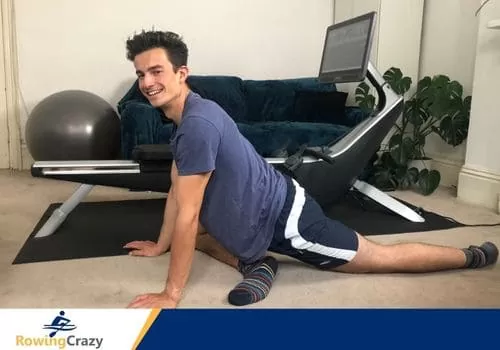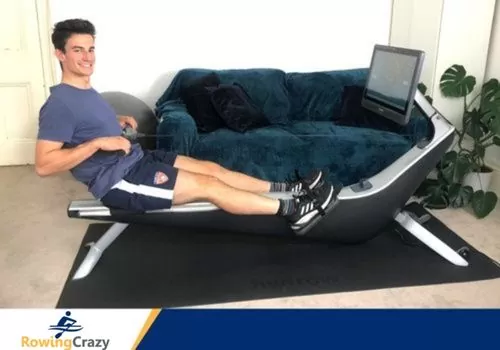
Through my rowing journey, I’ve come up against many peaks and troughs over the years, and one of the biggest troughs I find is injury. Consequentially, preventing injuries is an important part of my rowing training, and one of the best ways to do that is by improving mobility.
Mobility and Its Benefits to Rowers
Improving mobility has quite a few benefits to rowing.
- Firstly, as I have mentioned above, it helps you to prevent injury.
- Secondly, it can improve your rowing stroke, as more flexibility will allow you to comfortably get into better ‘longer’ positions.
- Finally, you’ll be able to train to become stronger in these better positions – in the weight room, on the rowing machine, and on the water, thus you’ll find that you can become a much faster (and stronger) rower from it.

Max Secunda Working Out on a Hydrow Rowing Machine
What Is Mobility?
A good formula for understanding mobility is as follows:
Flexibility + Strength = Mobility
Mobility isn’t merely spending hours upon hours stretching your hamstrings so that you can touch your toes with straight legs and do the splits. It’s more about developing strength through all of your ranges of motion and extending those ranges of motion as you do so.
Through this article, I will be splitting mobility into these two aspects and discussing how you can improve your mobility by focusing on both strength training and flexibility exercises.
Testing Mobility
Before you dive straight into your stretching and strength training exercises to improve mobility, it’s best to evaluate how your body is moving at the moment. This will allow you to focus your efforts more on your weaker areas – to bring them up to parts where you’re already mobile.
Here are a few exercises to assess your mobility.
Overhead Squat
The overhead squat is a fantastic exercise for assessing your mobility, not to mention that it is also a fantastic exercise in general.
Using a broom handle or a PVC tube (or anything long, cylindrical, and lightweight), hold the bar with a wide grip (much wider than shoulder width) above your head directly over your spine (you might need to adjust this to start with, depending upon your current state of flexibility), and squat down. Be sure to try to keep the bar over your spine and your torso upright as you do so.
Chances are this is going to be extremely hard to perform with proper form (hence the importance of starting with some lightweight tubing instead of a barbell!). When I first performed this exercise, I found that my shoulders, traps, and lats were incredibly tight, preventing me from keeping the bar travel down in a straight line (as viewed side on) whilst I was squatting. So, I knew those were parts of my body I had to improve mobility on!
I also struggled to hit a good depth on the squat when in this position. This was something that surprised me as I normally don’t struggle with this when doing regular back squats. Consequentially, I discovered that most of my leg muscles needed a bit of loosening up!
Deep Squat
Mobility is rarely an issue with children because humans are born with mobile joints. However, through years of sitting and not regularly exploring our full range of motion, we lose this mobility.
It’s common to see children in a deep squat as they play and explore the world. Imagine them fully squatted down, feet flat on the floor, and knees bent fully with their hamstrings touching their calves (see how I do it below). Try asking most adults to try and get into this position – I bet they’ll find it very difficult!

Deep Squats for Testing Mobility
Being able to sit comfortably in a deep squat is a very good indicator of good lower body mobility. If you can’t sit comfortably in a position where your feet are flat and your hamstrings are touching your calves, then it is important to consider why this position is uncomfortable.
This will likely be causing you an issue in your rowing stroke or could be a potential weak part in your kinetic chain that will, at some point, develop an injury.
For many, tight hamstrings will be at fault, but this isn’t exclusively the reason. It also has something to do with ankle mobility or hip and glute mobility.
As you’re trying to move into a deep squat position, be aware of your body and what’s limiting you from reaching and being comfortable in that position. You’ll likely be able to feel the tightness and therefore identify by yourself what’s preventing you from being comfortable in that position.
Developing Flexibility
Stretching is the best way to develop flexibility, but we must be careful in our approach to stretching. It is easy (especially for competitive people) to try and immediately start pushing our limits and going for deeper and deeper stretches. This is something that will ultimately lead you to developing muscle strains and injuries.
When stretching, stretch until the point at which you feel the stretch and feel the slight pulling feeling in the muscle you’re working on. Try to relax into the position and let the stretch become easier as you relax into it – don’t reach further and start pushing your limits!
Flexibility is something you develop over time, much like fitness. It takes a level of commitment to build and maintain – so the best way to start developing flexibility is engraining stretching into your workout routines. Perhaps at the end of every session, spend 5 minutes working on your weak points.
Here are some key stretches that you can do to develop flexibility.
Hamstrings
Hamstrings tend to be the go-to stretch for most people exercising – and rightly so! Hamstring flexibility is hugely important in rowing. With poor hamstring flexibility, you’ll be unable to get into strong catch and finish positions as you’re working through the rowing stroke.
My personal favorite hamstring stretch is the lying hamstring stretch. Here are the steps to perform this stretch:
- Lie on your back, body relaxed, allow one of your knees to generously bend (this puts the hips into a neutral position).
- Raise your other leg (keeping it as straight as comfortable) so that you’re pointing the sole of your foot upwards (see image below).
- You can use a towel or a resistance band around your foot to help pull your leg towards you – being careful not to over-reach yourself – just stretch to a point at which you’re feeling the stretch down your hamstrings.

Hamstring Stretches to Develop Flexibility
I also find variety when stretching to be very beneficial, so here are some alternative hamstring stretches:
- Sitting hamstring stretch – sit on the floor and pull one foot towards the top of your leg, stretch your other leg out straight and lean forwards reaching towards your toes (see image below).

Stretch Variation to Improve Flexibility – Sitting Hamstring Stretch
- Standing hamstring stretch – this one is a very simple one (but still effective!). Standing up, slightly bend your knees (a soft bend) and hinge from the hips (like a Romanian Deadlift), leaning forwards until you feel the stretch in your hamstrings.
Glutes
My personal favourite stretch for glute flexibility is the Pigeon pose. To do this, position one leg in front of you on the floor so that your shin is at a right angle (or as near as you can comfortably get it) to your body. Stretch your other leg back behind you and lean forwards slightly – see image below. You should feel a strong stretch across your glute.

Max Secunda Doing a Pigeon Stretch for Glute Flexibility
Other Muscle Groups
Of course, these are just two key muscle groups to stretch, but from personal experience, I’ve found the most gain from rowing by focusing on these two muscle groups.
Below is a list of stretches for other muscle groups:
- Standing Quad Stretch (Hips and Quads)
- Lunging Hip Flexors Stretch (Hips)
- Child’s Pose (Lats)
- Sleeper Stretch (Shoulders)
- Piriformis Stretch (Glutes and Lower Back)
- Cat-Cow (Back)
Foam Rolling
Foam rolling and sports massage can also help develop mobility and ease muscle pain and DOMS after rowing workouts.
Foam rolling is far cheaper than sports massage, but with massage, you get the benefit of a trained masseuse who will be able to support you in working out any problems or injuries you may have.
You can buy a foam roller for a fraction of the price of a single massage – anywhere from $5-15, or slightly more if you’re looking for a branded or more specialized roller. For most people, a basic, medium-density or medium-hardness foam roller will solve all their muscle pains and mobility issues.
Foam rolling can initially be slightly painful (much like a massage) as the roller presses hard on your muscles, ultimately helping you to relax, stretch, and improve blood flow (aiding mobility).
Tips for Foam Rolling
Getting started with foam rolling is very simple – just a few key points to remember before diving in:
- Don’t directly foam roll your joints (Instead, foam roll the muscles around them)
- Avoid foam rolling your lower back (Although this is quite a hotly contested subject)
- Always listen to a medical professional over a rower on the internet (If a physio’s advice differs to mine, listen to the physio!)
Steps to Get Started with Foam Rolling
- To start foam rolling, position your roller on the floor – make sure you’re in a fairly open space as you’ll find you’ll move around and spread out a lot.
- Place the muscle that you wish to massage/roll onto the roller and allow your body weight to press down onto the muscle – this may be painful to start with, but the more you roll the easier it gets. If it is very painful, take some of the weight off by using your other limbs to support your weight.
- Start to roll your muscle on the roller – two inches in one direction and then one inch back. If you find a knot – these are especially painful areas to roll over, or a place where your muscle feels a bit ‘clunky’ or ‘clicky’ (you’ll know exactly what I mean when you feel it!), allow the foam roller to press on it for about 20 seconds.
- Allow your muscle to relax as you do so – this will help release the knot. It’ll probably take a few sessions of rolling to fully release it, but the fewer knots you have, the greater your mobility!
Developing Strength
Finally, I come to the developing strength section. As we discussed earlier, mobility is a combination of flexibility and strength through a range of motion. Consequentially, we should look to develop our strength through complete motions.
I shall briefly discuss some of the benefits of regularly performing strength training exercises and how they will help in your rowing workout and improve your rowing movement.
Weight training has a huge number of benefits. Not only does it allow you to exercise your upper body (which as rowers we sometimes don’t do enough) and build your core strength but also helps you build up your strength right across your body.
Weight training has the effect of helping you drop splits when you’re back on the rowing machine. In terms of mobility, it’s going to help you become stronger throughout the different motions involved in the rowing stroke.
I highly recommend the following strength training exercises.
Core Training for Rowing

Max Secunda working out on a Hydrow Rower
The core is used throughout the rowing stroke. Your core allows you to hang off the handle through the drive phase of the stroke and maintain a strong finish position.
In terms of mobility, having a strong core (which includes back muscles as well as the abdomen) allows you to stay supported through your trunk in all positions. It also allows you to balance better and, of course, help prevent injury.
There are tonnes of core exercises to choose from, so I’ve made a list below of some of my favorites. Choose 9 and work through them 45 seconds on 15 seconds off. Try to choose a mix of rotational, leg raising, upper body raising, and hold exercises.
Good Core Exercises

- Sit up
- Russian twists (using a medicine/stability ball)
- Plank
- Side plank (left and right)
- V-sit ups
- V-sit holds
- Mountain Climbers
- Super Mans
- Scullers
- Bird Dog
- Thread the needle
- Weighted sit ups
- Hanging leg raises
- Leg raises
- Ab crunches
- Swimmers legs
- Figures of eight
- Dead bug
- One arm plank
- Kettlebell swings
Single Leg Exercises
In all sports, no matter how symmetrical we feel, it’s often the case that we’ve developed some muscle imbalances. This is especially true in sweep rowing – where the inside leg takes the initial squeeze of pressure, then the outside leg takes over towards the end of the stroke – even when you feel like you’re pressing equally. This is why single leg exercises are very important for rowers.
- Lunges are a great exercise to redress any muscle imbalances, and even better, you can perform it without any equipment!
- Carry dumbbells in your hands or use a barbell to add weight if you want to make the exercise harder.
- Alternatively try jumping lunges, where you change legs each jump to add a bit of lactic burn to the workout! Your rowing performance will definitely benefit from this one leg exercise!
- Try single leg variations of the squat. My favorite (or should I say least favorite because it’s a really tough one) is the Bulgarian Split Squat.
These are fantastic exercises for training each leg individually.
Other Notable Exercises
I’ve written an article where I go into greater detail about strength training exercises for rowers. So here, I’ll just list a few of my favourite exercises for rowers (and more details can be found in my strength training specific article):
- Back squat
- Front squats
- Romanian deadlift
- Barbell deadlift
- Pull ups
- Push ups
- Bench pull
- Bench press
- Overhead press
Of course, the most important thing when lifting is to use good technique throughout the session (allow time for adequate recovery between lifts). Make sure you take the time to learn form and always look for ways to improve technique when lifting. This will also help you build strength and avoid injury!
In terms of the number of repetitions (reps) and sets that you should be performing, here’s my tip.
If you’re new to lifting and weights, consider a beginners strength training program such as strong lifts 5×5 (5 reps for 5 sets). This is challenging enough for a beginner to make quick gains in strength, but it also allows time to rest and recover in-between.
More experienced lifters might want to consider other programmes that are more tailored to either hypertrophy or strength. Each have their own benefits for rowing, but you should choose a program based on your current goals.
Concluding Thoughts

Max Secunda showing the Finish Phase of a Rowing Stroke
I hope that I’ve explained away in this article the misconception that mobility is exactly the same as flexibility. Hopefully, it’s now clear to you that mobility comes as a combination of developing strength and flexibility through a range of motion.
We’ve looked at a few ways to assess our mobility and some ways to fix the issues we come across along the way. It’s important to be consistent when we’re trying to improve our mobility – like everything, practice makes perfect!
Improving mobility will certainly help you through your rowing workout and improve your rowing technique.
You might see it as a bit of a challenge to improve your mobility, but I urge you to stretch your limits, and I have no doubts that you can do it!
Written by Max Secunda – RowingCrazy.com
Experienced Heavy Weight Rower, Rowing Instructor & Coach, Novice Men’s Rowing Captain, British Concept 2 Record Holder & Rowing YouTube Influencer
Max is a rower at Vesta Rowing Club based in London, UK. He started rowing at the University of Sheffield, where he also was the Captain of the Novice Men’s Rowing Team, Max has a well know YouTube channel where he vlogs about his rowing training and experiences.





